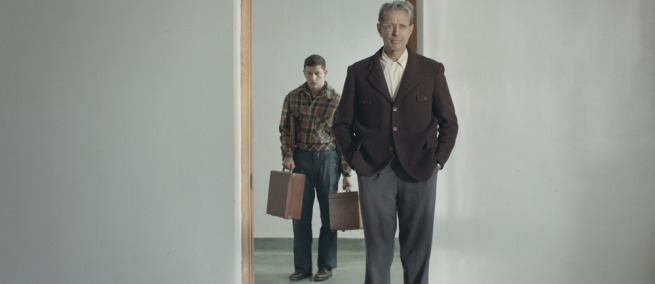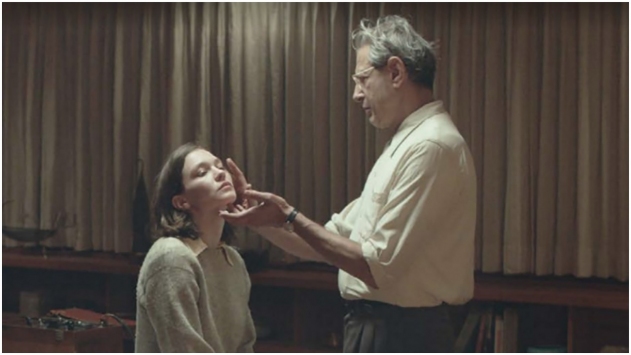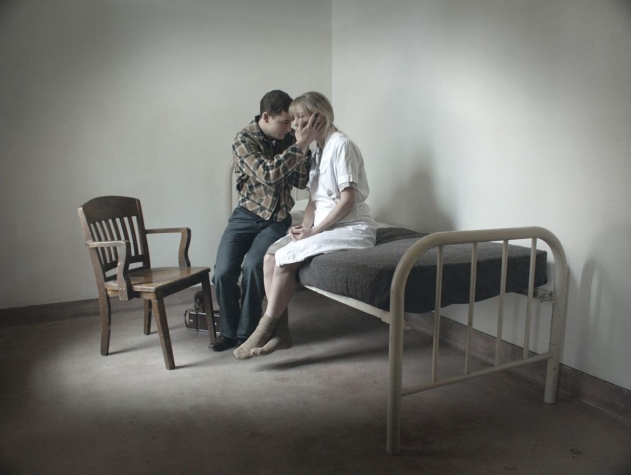
Set in 1950s America, Rick Alverson’s new film THE MOUNTAIN stars Jeff Goldblum and Tye Sheridan in a story loosely based on the man who invented the lobotomy procedure in the U.S. The film made its world premiere at the 2019 Sundance Film Festival and is now in theaters. Goldblum plays Dr. Wallace Fiennes, who brings a young man named Andy (Tye Sheridan) with him as photographer on what may be a final tour of psychiatric institutions. Dr. Fiennes performs a lobotomy on woman after woman. THE MOUNTAIN also stars Hannah Gross (MIND HUNTER), Denis Lavant (HOLY MOTORS), and Uto Kier (BLADE). We sat down with Alverson at Cinetic’s office in Manhattan on July 24.
Science & Film: Why were you inspired to base this film, however loosely, on the life of Walter Freeman?
Rick Alverson: I knew about him and the more I looked into his life story—taking a European procedure [called] the leucotomy and changing it—the more his story conformed to a certain interest that I have in American psyches. Freeman went behind the back of [James] Watts, the surgeon with whom he worked, and started experimenting with how to do this [procedure] more efficiently, quicker, and for all intents and purposes because it didn’t require a surgeon, almost as an outpatient procedure. It’s very in keeping with fast food culture. The procedure was applied so broadly. His pride is very evident, particularly in those later years, and also a layered, buried guilt.
Walter Freeman spent a lot of years trying to justify the procedure and prove through very unscientific means—travelling around to patients and carrying postcards—that the procedure was beneficial. He is a very complex character and very particularly American.
S&F: What source material did you find useful?
RA: Freeman has an unpublished autobiography that ultimately wasn’t entirely useful. Jeff [Goldblum] and I spoke to some children of patient’s of his, which was harrowing and instrumental. And we acquired Psychosurgery, his book, which is kind of expensive and hard to find. Freeman also directed 16mm films that are on YouTube of the transorbital lobotomy procedure. They are very graphic and were useful for us. But ultimately, I wanted to use some of the architecture of his decline, [when he was] in a state of denial, which became a foundation for a very fictionalized version of his life. I didn’t see any evidence that Freeman was a womanizer or a drunk, although it seems he did have a pill problem.
There is a lot that is fictional in the film, but I did want to conform to the plausible in the behavior of an historic figure. Freeman performed some procedures in homes, maybe even in a few motel rooms. Of the science of it all, the strange thing is that he was onto something. In a rebellion against the Freudian, he believed that there is a physical—suggestive of a chemical—neurological basis to problems of mental illness. He was right. His approach was in completely arbitrary fashion, medieval in a certain way: essentially stirring up neural connections in the frontal lobe without understanding what they are and then basing the science on the evidence, and then denying the evidence in some sort of psychological slight of hand. Another thing is that because Freeman didn’t want to have an anesthesiologist he used electroshock therapy as anesthesia and he had five to seven minutes to perform the procedure!

S&F: Of the lobotomies that you show in the film, almost all are performed on female patients. Can you talk about why you made that choice?
RA: The film looks at unrealized and impossible utopias that are blindly, devotionally pursued by male characters through a willful ignorance of the limitations of the world. But it also looks at the gulf, particularly in that era, between the institutionalized and the socialized, and the attributes of genders. You conform to a certain set of attributes when other attributes are unavailable to you; the film looks at the distortions in a would-be whole individual that creates. By showing the procedure across rigid gender lines, it heightens that divide I think. Figuratively, it’s also a very male procedure. The idea of forced stoicism, conformity, the ordered, rational, are all [male] attributes from the ’50s. The lobotomy is a normative procurer that is quieting the untenable emotion and aberration of personalities. It is strangely consistent with what men do to themselves [laughs] and everyone around them. Those men suffer from it too. They can also be the beneficiaries of it, but they’re not whole people.
S&F: Would you go as far as to say that the lobotomy in your film is a utopian procedure, in that it neuters people into a state that’s good for everyone around them?
RA: Well it puts them into a passive state. Readable metaphors in film always bothered me, and symbolism, but then I started to realize over the last few films that it’s a grammar. You’re taught and conditioned to read films, unfortunately, rather than just experience them. So we read them like literature as a safe way of disconnecting us from the experience. They need to be a reprieve from the volatility of the world rather than something else. Over my last couple of films, I started to struggle, wrestle, and interact with using metaphors and symbolism as raw materials. There is a blatant metaphor here and that is that audiences are subjecting themselves to pacification by all of narrative—by seeing this film. But this film muddies the waters; it pretends to be an anesthetic delivery device for passivity, like any film, but then it becomes dysfunctional once you’re in it so hopefully does the opposite of pacify.
S&F: It pretends to deliver a happy ending, too.
RA: It’s a big pretend [laughs]. I don’t know anybody who reads that as a happy ending.
S&F: Well… There is a sort of dreamlike quality.
RA: It pretends to deliver an ending, let’s just say that. [laughs]. I think that she’s thinking in that car as he quivers, looking for a mountain that he’s on top of by staring into the clouds, she’s sitting in the car thinking here we go again. [chuckles]

S&F: She is great.
RA: Hannah [Gross] is great.
S&F: What was it like working with her on the portrayal of someone who has been lobotomized?
RA: When production is working best there is giddiness even around very serious things because you feel energized, and it can be light and good. Hannah and I talked a lot about her character, since she is probably the only character in the film that has a kind of true volition. She moves into this space in almost a martyrdom because she knows what it is and chooses it. It’s a perversion of submissiveness. It’s a really strange, sad, but authored choice. He [Andy] follows her into that place. And that place is something unknown to the audience because we don’t know how they were altered. That interests me a lot too.
I think cinema needs more characters like that. In episodic television and most film there are sympathetic characters to whom we have total, unlimited access because they are typically like ourselves in some way—they conform to a demographic or have characteristics that we find pleasing. I think it’s actually changing us. It is affecting us physiologically and psychologically in ways that we’re unaware.
S&F: Do you think it changes our relationships with real people?
RA: Yeah, I think that access to sympathetic characters literally reinforces our capacity for bigotry out on the street. It certainly isn’t exercising our capacity to consider the other. Most of the people you see on the street, you have no idea what the fuck they’re thinking. We just sort of ignore that and we tap for the sympathetic character. This is something ingrained in our physiology as homo sapiens but this is civilization, after all, shouldn’t we be trying to spread our wings a little bit?! The majority of films just validate our worldview, they don’t challenge our worldview. Otherwise they’re not consumable or they’re problematic or they’re difficult. We consume so much, so as everything starts to conform it creates a hall of mirrors.
S&F: The way the inscrutability of Tye Sheridan's character plays out in the film makes Jeff Goldblum’s character somewhat more sympathetic, because he’s easier to read.
RA: Sure, yeah. That is part of the reason why [Jeff Goldblum] drops off the earth in the film, because I wanted us to feel his absence. I wanted us to struggle. And people do struggle with the film so it’s successful to that degree. Some people read that as a failure, as like, it went off the rails in the third act orit just falls flat. I’m like okay, what you’re experiencing is that your friend and guide with all of his faults has left you, and now you have to struggle in this horrific universe. God forbid you squirm in your seat a little bit while you’re taking a tour of the horrors. And I don’t hate audiences. I’m an audience. I just think that things have gone wrong. We’ve been bad parents. [laughs]

Rick Alverson. Photo by Araya Diaz/Getty Images.
THE MOUNTAIN is now in theaters. It is written, directed, and edited by Rick Alverson and co-written by Colm O’Leary and Dustin Guy Defa. Alverson’s other films include ENTERTAINMENT (2015) and THE COMEDY (2012).
TOPICS